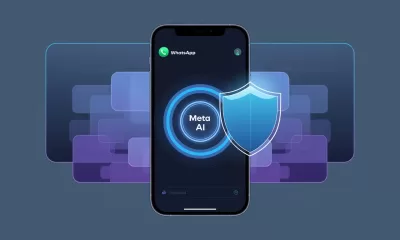Life
AI at the Polls: Is Technology Steering the 2024 US Election?
As Americans cast their votes tomorrow, artificial intelligence will play a quiet but powerful role behind the scenes.
Published
6 months agoon
By
AIinAsia
TL;DR:
- Campaign ads, social media feeds, and even “news” popping up in swing states are being shaped by AI’s invisible hand
- Campaigns in 2024 aren’t just reaching voters; they’re diving deep into our digital footprints
- AI brings campaigns closer to voters, it also makes it easier than ever to spread misinformation
A New Political Battleground—Inside the AI-Powered Election
As Americans cast their votes tomorrow, artificial intelligence will play a quiet but powerful role behind the scenes. Campaign ads, social media feeds, and even “news” popping up in swing states are being shaped by AI’s invisible hand. This isn’t just the next step in election tech; it’s a dramatic leap that could change the game forever. Is AI enhancing democracy, or are we giving it the keys to the whole democratic car?
1. Supercharging Campaigns: Microtargeting to the Extreme
Let’s face it—if you feel like your social media feeds are eerily personal, that’s not a coincidence. Campaigns in 2024 aren’t just reaching voters; they’re diving deep into our digital footprints to send messages so tailored they feel like personal letters. Thanks to AI, campaigns can slice the electorate into precise segments, tapping into anxieties, interests, and even specific local issues.
In battleground states like Arizona and Pennsylvania, this tech-driven targeting reaches a fever pitch. AI sifts through oceans of data—social media interactions, browsing habits, even purchase history—to craft ads that connect directly with you, personally.
“Campaigns are increasingly leveraging sophisticated machine learning algorithms to analyse vast quantities of voter data, refining their strategies with pinpoint accuracy,” notes MIT Technology Review (source).
With AI knowing so much, it raises an interesting (if slightly chilling) question: where’s the line between effective campaigning and outright manipulation?
2. The Double-Edged Sword: AI, Deepfakes, and Digital Misinformation
Here’s the darker side. While AI brings campaigns closer to voters, it also makes it easier than ever to spread misinformation. AI-generated deepfakes—fake videos that look so real you wouldn’t know they’re fake—have added a surreal twist to this election. Imagine seeing a video of a candidate saying something outrageous… and then realising it never actually happened.
“Deepfakes have made the spread of disinformation much easier and more convincing, raising concerns about the future of truth in politics,” the Brookings Institution warns (source).
AI’s power to create convincing fakes isn’t just a technical marvel; it’s a fundamental threat to truth in politics. Without strict regulations or ways to fact-check in real-time, we’re left wondering how many people will cast their vote based on a lie.
3. Predictive Polling: AI, Sentiment Analysis, and the All-Seeing Eye
If you thought AI was only influencing what you see online, think again. Polling has evolved far beyond traditional methods. This election, campaigns are using AI-driven sentiment analysis to tap into public moods in real time, keeping a pulse on issues that resonate with voters minute by minute.
“Sentiment analysis enables campaigns to see beyond traditional polling, observing shifts in public mood and identifying emerging concerns as they happen,” reports the Pew Research Center (source).
Let’s say economic concerns are heating up in Georgia; Trump’s team could amplify ads focusing on job growth in just hours. Or Harris’s camp could hone in on climate change in Michigan based on AI-driven insights from yesterday’s online conversations. This real-time fine-tuning isn’t just impressive—it’s a little mind-bending. Can polls really capture the pulse of the nation, or are we just seeing what AI’s algorithms want us to?
4. Mobilising the Masses: AI Nudges and Digital Persuasion
Getting people to the polls has always been crucial, and AI’s here to make sure more people than ever get nudged, reminded, and maybe even guilt-tripped into voting. AI-driven models predict not only who’s likely to vote but also who might need a little extra encouragement. Campaigns can then send targeted texts, emails, or even pop up on your social feed reminding you to “make your voice heard.”
The Atlantic remarks on AI’s power in mobilisation, stating, “AI has transformed voter outreach into an exact science, enabling campaigns to efficiently target and mobilise segments of the electorate that might otherwise stay home” (source).
For instance, Harris’s campaign has deployed AI to boost turnout among younger voters in key states, while Trump’s team uses it to rally dedicated supporters in traditionally red zones. AI doesn’t just follow you online; it’s practically waiting outside your door with a “Don’t forget to vote” sign. This kind of outreach raises a fascinating question about voter autonomy—are we freely deciding to vote, or are we being nudged by an algorithm?
5. Navigating the Ethical Minefield: Can Democracy Keep Up?
Here’s where it all gets tricky. While AI offers stunning capabilities for reaching, engaging, and mobilising voters, it also opens up new doors for potential misuse. From deepfakes to ultra-targeted political ads, AI is testing the limits of what’s fair game in political campaigns.
With regulations still trying to catch up, we’re left with a significant blind spot.
“Current frameworks for AI regulation are woefully inadequate, leaving a critical gap in safeguarding electoral processes,” states the Harvard Political Review (source).
AI has handed campaigns a powerful toolkit, but with great power comes… well, you know the rest. Without real oversight, there’s a real risk of crossing ethical lines, leaving voters questioning whether their choices are truly their own or just the echoes of an algorithm.
A Glimpse into Asia’s Future?
As AI’s influence in US elections becomes clear, Asia’s political landscape might not be far behind. In a region where social media is booming and governments increasingly leverage AI for everything from citizen services to surveillance, the potential for AI-driven election strategies is immense. Imagine a world where voter preferences in Tokyo, Jakarta, or Delhi are meticulously profiled, and campaign ads are hyper-personalised to every demographic, language, and cultural nuance. But here’s the question for Asia: with AI’s rapid adoption and limited oversight, who will control this powerful tool—governments, political parties, or the people? The US election offers a glimpse of how AI can shape democracy, but will Asia be able to harness this power responsibly, or could it open doors to unprecedented political manipulation? The stakes are high, and the path ahead remains uncharted.
Join the Conversation
How do you think AI will impact elections in Asia? Will it drive democracy forward or lead to new challenges in political manipulation? Leave a comment or subscribe for AI in Asia updates.
You may also like:
- AI Voice Cloning: A Looming Threat to Democracy
- AI Chatbots Struggle with Real-Time Political News: Are They Ready to Monitor Elections?
- AI-Fakes Detection Is Failing Voters in the Global South
- To learn more about the role of AI in the US elections, tap here.
Author
Discover more from AIinASIA
Subscribe to get the latest posts sent to your email.
You may like
Business
Build Your Own Agentic AI — No Coding Required
Want to build a smart AI agent without coding? Here’s how to use ChatGPT and no-code tools to create your own agentic AI — step by step.
Published
15 hours agoon
May 9, 2025By
AIinAsia
TL;DR — What You Need to Know About Agentic AI
- Anyone can now build a powerful AI agent using ChatGPT — no technical skills needed.
- Tools like Custom GPTs and Make.com make it easy to create agents that do more than chat — they take action.
- The key is to start with a clear purpose, test it in real-world conditions, and expand as your needs grow.
Anyone Can Build One — And That Includes You
Not too long ago, building a truly capable AI agent felt like something only Silicon Valley engineers could pull off. But the landscape has changed. You don’t need a background in programming or data science anymore — you just need a clear idea of what you want your AI to do, and access to a few easy-to-use tools.
Whether you’re a startup founder looking to automate support, a marketer wanting to build a digital assistant, or simply someone curious about AI, creating your own agent is now well within reach.
What Does ‘Agentic’ Mean, Exactly?
Think of an agentic AI as something far more capable than a standard chatbot. It’s an AI that doesn’t just reply to questions — it can actually do things. That might mean sending emails, pulling information from the web, updating spreadsheets, or interacting with third-party tools and systems.
The difference lies in autonomy. A typical chatbot might respond with a script or FAQ-style answer. An agentic AI, on the other hand, understands the user’s intent, takes appropriate action, and adapts based on ongoing feedback and instructions. It behaves more like a digital team member than a digital toy.
Step 1: Define What You Want It to Do
Before you dive into building anything, it’s important to get crystal clear on what role your agent will play.
Ask yourself:
- Who is going to use this agent?
- What specific tasks should it be responsible for?
- Are there repetitive processes it can take off your plate?
For instance, if you run an online business, you might want an agent that handles frequently asked questions, helps users track their orders, and flags complex queries for human follow-up. If you’re in consulting, your agent could be designed to book meetings, answer basic service questions, or even pre-qualify leads.
Be practical. Focus on solving one or two real problems. You can always expand its capabilities later.
Step 2: Pick a No-Code Platform to Build On
Now comes the fun part: choosing the right platform. If you’re new to this, I recommend starting with OpenAI’s Custom GPTs — it’s the most accessible option and designed for non-coders.
Custom GPTs allow you to build your own version of ChatGPT by simply describing what you want it to do. No technical setup required. You’ll need a ChatGPT Plus or Team subscription to access this feature, but once inside, the process is remarkably straightforward.
If you’re aiming for more complex automation — such as integrating your agent with email systems, customer databases, or CRMs — you may want to explore other no-code platforms like Make.com (formerly Integromat), Dialogflow, or Bubble.io. These offer visual builders where you can map out flows, connect apps, and define logic — all without needing to write a single line of code.
Step 3: Use ChatGPT’s Custom GPT Builder
Let’s say you’ve opted for the Custom GPT route — here’s how to get started.
First, log in to your ChatGPT account and select “Explore GPTs” from the sidebar. Click on “Create,” and you’ll be prompted to describe your agent in natural language. That’s it — just describe what the agent should do, how it should behave, and what tone it should take. For example:
“You are a friendly and professional assistant for my online skincare shop. You help customers with questions about product ingredients, delivery options, and how to track their order status.”
Once you’ve set the description, you can go further by uploading reference materials such as product catalogues, FAQs, or policies. These will give your agent deeper knowledge to draw from. You can also choose to enable additional tools like web browsing or code interpretation, depending on your needs.
Then, test it. Interact with your agent just like a customer would. If it stumbles, refine your instructions. Think of it like coaching — the more clearly you guide it, the better the output becomes.
Step 4: Go Further with Visual Builders
If you’re looking to connect your agent to the outside world — such as pulling data from a spreadsheet, triggering a workflow in your CRM, or sending a Slack message — that’s where tools like Make.com come in.
These platforms allow you to visually design workflows by dragging and dropping different actions and services into a flowchart-style builder. You can set up scenarios like:
- A user asks the agent, “Where’s my order?”
- The agent extracts key info (e.g. email or order number)
- It looks up the order via an API or database
- It responds with the latest shipping status, all in real time
The experience feels a bit like setting up rules in Zapier, but with more control over logic and branching paths. These platforms open up serious possibilities without requiring a developer on your team.
Step 5: Train It, Test It, Then Launch
Once your agent is built, don’t stop there. Test it with real people — ideally your target users. Watch how they interact with it. Are there questions it can’t answer? Instructions it misinterprets? Fix those, and iterate as you go.
Training doesn’t mean coding — it just means improving the agent’s understanding and behaviour by updating your descriptions, feeding it more examples, or adjusting its structure in the visual builder.
Over time, your agent will become more capable, confident, and useful. Think of it as a digital intern that never sleeps — but needs a bit of initial training to perform well.
Why Build One?
The most obvious reason is time. An AI agent can handle repetitive questions, assist users around the clock, and reduce the strain on your support or operations team.
But there’s also the strategic edge. As more companies move towards automation and AI-led support, offering a smart, responsive agent isn’t just a nice-to-have — it’s quickly becoming an expectation.
And here’s the kicker: you don’t need a big team or budget to get started. You just need clarity, curiosity, and a bit of time to explore.
Where to Begin
If you’ve got a ChatGPT Plus account, start by building a Custom GPT. You’ll get an immediate sense of what’s possible. Then, if you need more, look at integrating Make.com or another builder that fits your workflow.
The world of agentic AI is no longer reserved for the technically gifted. It’s now open to creators, business owners, educators, and anyone else with a problem to solve and a bit of imagination.
What kind of AI agent would you build — and what would you have it do for you first? Let us know in the comments below!
You may also like:
- How To Start Using AI Agents To Transform Your Business
- Revolution Ahead: Microsoft’s AI Agents Set to Transform Asian Workplaces
- AI Chatbots: 10 Best ChatGPTs in the ChatGPT Store
- Or tap here to try this out now at ChatGPT by tapping here.
Author
Discover more from AIinASIA
Subscribe to get the latest posts sent to your email.
Life
Which ChatGPT Model Should You Choose?
Confused about the ChatGPT model options? This guide clarifies how to choose the right model for your tasks.
Published
22 hours agoon
May 9, 2025By
AIinAsia
TL;DR — What You Need to Know:
- GPT-4o is ideal for summarising, brainstorming, and real-time data analysis, with multimodal capabilities.
- GPT-4.5 is the go-to for creativity, emotional intelligence, and communication-based tasks.
- o4-mini is designed for speed and technical queries, while o4-mini-high excels at detailed tasks like advanced coding and scientific explanations.
Navigating the Maze of ChatGPT Models
OpenAI’s ChatGPT has come a long way, but its multitude of models has left many users scratching their heads. If you’re still confused about which version of ChatGPT to use for what task, you’re not alone! Luckily, OpenAI has stepped in with a handy guide that outlines when to choose one model over another. Whether you’re an enterprise user or just getting started, this breakdown will help you make sense of the options at your fingertips.
So, Which ChatGPT Model Makes Sense For You?
Currently, ChatGPT offers five models, each suited to different tasks. They are:
- GPT-4o – the “omni model”
- GPT-4.5 – the creative powerhouse
- o4-mini – the speedster for technical tasks
- o4-mini-high – the heavy lifter for detailed work
- o3 – the analytical thinker for complex, multi-step problems
Which model should you use?
Here’s what OpenAI has to say:
- GPT-4o: If you’re looking for a reliable all-rounder, this is your best bet. It’s perfect for tasks like summarising long texts, brainstorming emails, or generating content on the fly. With its multimodal features, it supports text, images, audio, and even advanced data analysis.
- GPT-4.5: If creativity is your priority, then GPT-4.5 is your go-to. This version shines with emotional intelligence and excels in communication-based tasks. Whether you’re crafting engaging narratives or brainstorming innovative ideas, GPT-4.5 brings a more human-like touch.
- o4-mini: For those in need of speed and precision, o4-mini is the way to go. It handles technical queries like STEM problems and programming tasks swiftly, making it a strong contender for quick problem-solving.
- o4-mini-high: If you’re dealing with intricate, detailed tasks like advanced coding or complex mathematical equations, o4-mini-high delivers the extra horsepower you need. It’s designed for accuracy and higher-level technical work.
- o3: When the task requires multi-step reasoning or strategic planning, o3 is the model you want. It’s designed for deep analysis, complex coding, and problem-solving across multiple stages.
Which one should you pick?
For $20/month with ChatGPT Plus, you’ll have access to all these models and can easily switch between them depending on your task.
But here’s the big question: Which model are you most likely to use? Could OpenAI’s new model options finally streamline your workflow, or will you still be bouncing between versions? Let me know your thoughts!
You may also like:
- What is ChatGPT Plus?
- ChatGPT Plus and Copilot Pro – both powered by OpenAI – which is right for you?
- Or try the free ChatGPT models by tapping here.
Author
Discover more from AIinASIA
Subscribe to get the latest posts sent to your email.
Life
Neuralink Brain-Computer Interface Helps ALS Patient Edit and Narrate YouTube
Neuralink enabled a paralysed ALS patient to use a brain-computer interface to edit a YouTube video and narrate with AI.
Published
2 days agoon
May 8, 2025By
AIinAsia
TL;DR — What You Need to Know:
- Bradford Smith, diagnosed with ALS, used Neuralink’s brain-computer interface to edit and upload a YouTube video, marking a significant milestone for paralyzed patients.
- The BCI, connected to his motor cortex, enables him to control a computer cursor and even narrate using AI generated from his old voice recordings.
- Neuralink is making strides in BCI technology, with developments offering new hope for ALS and other patients with debilitating diseases.
Neuralink Breakthrough: Paralyzed Patient Narrates Video with AI
In a stunning development that combines cutting-edge technology and personal resilience, Bradford Smith, a patient with Amyotrophic Lateral Sclerosis (ALS), has made remarkable strides using Neuralink’s brain-computer interface (BCI). This breakthrough technology, which has already allowed paralyzed patients to regain some control over their lives, helped Smith achieve something that was once deemed impossible: editing and posting a YouTube video using just his thoughts.
Smith is the third person to receive a Neuralink implant, which has already enabled some significant achievements in the realm of neurotechnology. ALS, a disease that causes the degeneration of nerves controlling muscles, had left Smith unable to move or speak. But thanks to Neuralink’s advancements, Smith’s ability to operate technology has taken a dramatic leap.
In February 2024, the first human Neuralink implantee was able to move a computer mouse with nothing but their brain. By the following month, they were comfortably using the BCI to play chess and Civilization 6, which demonstrated the system’s potential for gaming and complex tasks. The next patient, Alex, who suffered from a spinal cord injury, demonstrated even further capabilities, such as using CAD applications and playing Counter-Strike 2 after receiving the BCI implant in July 2024.
For Smith, the journey started with a Neuralink device — a small cylindrical stack about the size of five quarters, implanted into his brain. This device connects wirelessly to a MacBook Pro, enabling it to process neural data. Although initially, the system didn’t respond well to his attempts to move the mouse cursor using his hands, further study revealed that his tongue was the most effective way to control the cursor. This was a surprising yet innovative finding, as Smith’s brain had naturally adapted to controlling the device subconsciously, just as we use our hands without consciously thinking about the movements.
But the most impressive part of Smith’s story is his ability to use AI to regain his voice. Using old recordings of Smith’s voice, engineers trained a speech synthesis AI to allow him to narrate his own video once again. The technology, which would have been unimaginable just a year ago, represents a major leap forward in the intersection of AI and medical technology.
Beyond Neuralink, the field of BCI technology is rapidly advancing. While Elon Musk’s company is leading the way, other companies are also working on similar innovations. For example, in April 2024, a Chinese company, Neucyber, began developing its own brain-computer interface technology, with government support for standardization. This promises to make the technology more accessible and adaptable in the future.
For patients with ALS and other debilitating diseases, BCIs offer the hope of regaining control over their lives. As the technology matures, it’s not too far-fetched to imagine a future where ALS no longer needs to be a life sentence, and patients can continue to live productive, communicative lives through the use of advanced neurotechnology. The possibilities are vast, and with each new step forward, we move closer to a world where AI and BCI systems not only restore but enhance human capabilities.
Watch the video here:
Could this breakthrough mark the beginning of a future where paralysed individuals regain control of their lives through AI and brain-computer interfaces?
You may also like:
- How Did Meta’s AI Achieve 80% Mind-Reading Accuracy?
- AI-Powered News for YouTube: A Step-by-Step Guide (No ChatGPT Needed!)
- AI Music Fraud: The Dark Side of Artificial Intelligence in the Music Industry
- Or try the free version of Google Gemini by tapping here.
Author
Discover more from AIinASIA
Subscribe to get the latest posts sent to your email.

Build Your Own Agentic AI — No Coding Required

Which ChatGPT Model Should You Choose?

Neuralink Brain-Computer Interface Helps ALS Patient Edit and Narrate YouTube
Trending
-

 Marketing2 weeks ago
Marketing2 weeks agoPlaybook: How to Use Ideogram.ai (no design skills required!)
-

 Life2 weeks ago
Life2 weeks agoWhatsApp Confirms How To Block Meta AI From Your Chats
-

 Business2 weeks ago
Business2 weeks agoChatGPT Just Quietly Released “Memory with Search” – Here’s What You Need to Know
-

 Life5 days ago
Life5 days agoGeoffrey Hinton’s AI Wake-Up Call — Are We Raising a Killer Cub?
-

 Business5 days ago
Business5 days agoOpenAI Faces Legal Heat Over Profit Plans — Are We Watching a Moral Meltdown?
-

 Life4 days ago
Life4 days agoToo Nice for Comfort? Why OpenAI Rolled Back GPT-4o’s Sycophantic Personality Update
-

 Life6 days ago
Life6 days agoAI Just Slid Into Your DMs: ChatGPT and Perplexity Are Now on WhatsApp
-

 Business4 days ago
Business4 days agoIs Duolingo the Face of an AI Jobs Crisis — or Just the First to Say the Quiet Part Out Loud?




















